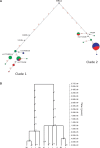Ancient and recent selective pressures shaped genetic diversity at AIM2-like nucleic acid sensors
- PMID: 24682156
- PMCID: PMC4007548
- DOI: 10.1093/gbe/evu066
Ancient and recent selective pressures shaped genetic diversity at AIM2-like nucleic acid sensors
Abstract
AIM2-like receptors (ALRs) are a family of nucleic acid sensors essential for innate immune responses against viruses and bacteria. We performed an evolutionary analysis of ALR genes (MNDA, PYHIN1, IFI16, and AIM2) by analyzing inter- and intraspecies diversity. Maximum-likelihood analyses indicated that IFI16 and AIM2 evolved adaptively in primates, with branch-specific selection at the catarrhini lineage for IFI16. Application of a population genetics-phylogenetics approach also allowed identification of positive selection events in the human lineage. Positive selection in primates targeted sites located at the DNA-binding interface in both IFI16 and AIM2. In IFI16, several sites positively selected in primates and in the human lineage were located in the PYD domain, which is involved in protein-protein interaction and is bound by a human cytomegalovirus immune evasion protein. Finally, positive selection was found to target nuclear localization signals in IFI16 and the spacer region separating the two HIN domains. Population genetic analysis in humans revealed that an IFI16 genic region has been a target of long-standing balancing selection, possibly acting on two nonsynonymous polymorphisms located in the spacer region. Data herein indicate that ALRs have been repeatedly targeted by natural selection. The balancing selection region in IFI16 carries a variant with opposite risk effect for distinct autoimmune diseases, suggesting antagonistic pleiotropy. We propose that the underlying scenario is the result of an ancestral and still ongoing host-pathogen arms race and that the maintenance of susceptibility alleles for autoimmune diseases at IFI16 represents an evolutionary trade-off.
Keywords: AIM2-like receptors; IFI16; long-standing balancing selection; positive selection.
Figures





Similar articles
-
Nature of selection varies on different domains of IFI16-like PYHIN genes in ruminants.BMC Evol Biol. 2019 Jan 17;19(1):26. doi: 10.1186/s12862-018-1334-7. BMC Evol Biol. 2019. PMID: 30654734 Free PMC article.
-
The DNA sensors AIM2 and IFI16 are SLE autoantigens that bind neutrophil extracellular traps.Elife. 2022 May 24;11:e72103. doi: 10.7554/eLife.72103. Elife. 2022. PMID: 35608258 Free PMC article.
-
The emerging role of human PYHIN proteins in innate immunity: implications for health and disease.Biochem Pharmacol. 2014 Dec 1;92(3):405-14. doi: 10.1016/j.bcp.2014.08.031. Epub 2014 Sep 6. Biochem Pharmacol. 2014. PMID: 25199457
-
The Absent in Melanoma 2-Like Receptor IFN-Inducible Protein 16 as an Inflammasome Regulator in Systemic Lupus Erythematosus: The Dark Side of Sensing Microbes.Front Immunol. 2018 May 28;9:1180. doi: 10.3389/fimmu.2018.01180. eCollection 2018. Front Immunol. 2018. PMID: 29892303 Free PMC article. Review.
-
Activation and Immune Regulation Mechanisms of PYHIN Family During Microbial Infection.Front Microbiol. 2022 Jan 25;12:809412. doi: 10.3389/fmicb.2021.809412. eCollection 2021. Front Microbiol. 2022. PMID: 35145495 Free PMC article. Review.
Cited by
-
IFI16 Targets the Transcription Factor Sp1 to Suppress HIV-1 Transcription and Latency Reactivation.Cell Host Microbe. 2019 Jun 12;25(6):858-872.e13. doi: 10.1016/j.chom.2019.05.002. Epub 2019 Jun 4. Cell Host Microbe. 2019. PMID: 31175045 Free PMC article.
-
TLR9 in MAFLD and NASH: At the Intersection of Inflammation and Metabolism.Front Endocrinol (Lausanne). 2021 Jan 29;11:613639. doi: 10.3389/fendo.2020.613639. eCollection 2020. Front Endocrinol (Lausanne). 2021. PMID: 33584545 Free PMC article. Review.
-
DGINN, an automated and highly-flexible pipeline for the detection of genetic innovations on protein-coding genes.Nucleic Acids Res. 2020 Oct 9;48(18):e103. doi: 10.1093/nar/gkaa680. Nucleic Acids Res. 2020. PMID: 32941639 Free PMC article.
-
A vast genomic deletion in the C56BL/6 genome affects different genes within the Ifi200 cluster on chromosome 1 and mediates obesity and insulin resistance.BMC Genomics. 2017 Feb 15;18(1):172. doi: 10.1186/s12864-017-3552-6. BMC Genomics. 2017. PMID: 28201990 Free PMC article.
-
TRIM22. A Multitasking Antiviral Factor.Cells. 2021 Jul 23;10(8):1864. doi: 10.3390/cells10081864. Cells. 2021. PMID: 34440633 Free PMC article. Review.
References
-
- Anisimova M, Bielawski JP, Yang Z. Accuracy and power of Bayes prediction of amino acid sites under positive selection. Mol Biol Evol. 2002;19:950–958. - PubMed
-
- Bandelt HJ, Forster P, Rohl A. Median-joining networks for inferring intraspecific phylogenies. Mol Biol Evol. 1999;16:37–48. - PubMed
-
- Barrett JC, Fry B, Maller J, Daly MJ. Haploview: analysis and visualization of LD and haplotype maps. Bioinformatics. 2005;21:263–265. - PubMed
Publication types
MeSH terms
Substances
Associated data
- Actions
- Actions
LinkOut - more resources
Full Text Sources
Other Literature Sources
Miscellaneous

